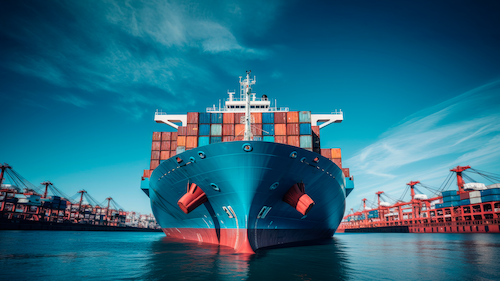Why in the News?
- India is constructing 54 naval vessels domestically, with up to 10 expected to join the fleet by December 2025.
- India is transitioning from foreign-built warships to domestic construction under the Atmanirbhar Bharat
- It aligns with India’s SAGAR vision, enhancing India’s role in the Indian Ocean Region (IOR) and countering regional challenges from China and Pakistan.
Key Highlights
- Scale and Scope of the Programme
- 54 vessels under construction in various shipyards, including frigates, anti-submarine craft, and support vessels.
- Fleet expansion target: Over 200 warships and submarines by 2035, potentially reaching 230 by 2037.
- All vessels expected to join the fleet by 2030, forming a long-term modernization roadmap.
- Indigenous Shipbuilding Momentum
- Guided by Atmanirbhar Bharat, the focus is on self-reliance and reducing import dependency.
- Economic impact: Creation of jobs in ancillary industries like steel, electronics, and shipbuilding.
- Example: INS Androth, an Anti-Submarine Warfare Shallow Water Craft (ASWSWC), with 80% indigenous content, built by GRSE Kolkata.
- Transition from Buyer’s Navy to Builder’s Navy
- Historical context: India largely depended on foreign warships; INS Tamal (July 2025) was the last major foreign-built frigate.
- Strategic shift: Emphasis on domestic design, construction, and technology transfer.
- Strategic Objectives
- Maritime security: India as a first responder in the IOR.
- Regional cooperation: Enhances partner capabilities through joint exercises and technology sharing.
- Supports SAGAR vision, promoting security and sustainable growth in the Indian Ocean.
- Recent Developments and Future Inductions
- Up to 10 domestically built warships to be commissioned by December 2025.
- Focus on stealth, multi-role capabilities, and high indigenous content.
- Progress indicates India’s long-term maritime self-reliance and strategic presence in the region.
Atmanirbhar Bharat
- Atmanirbhar Bharat, meaning “Self-Reliant India,” is a vision aimed at making the country economically stronger and more resilient.
- Self-reliance here does not imply isolation, but emphasizes strengthening domestic capacities while remaining engaged in the global economy.
- The goal is to build an economy capable of withstanding external shocks by promoting internal production and reducing dependency on imports.
- Economic Pillars of Atmanirbhar Bharat
- Boosting Domestic Manufacturing
- The initiative focuses on enhancing India’s manufacturing capabilities, including high-tech goods.
- Production Linked Incentive (PLI) schemes encourage companies to set up factories domestically.
- Boosting Domestic Manufacturing
- Objectives include job creation and transforming India into a global manufacturing hub.
- Reducing Import Dependency
- Producing goods locally reduces reliance on imports, saving foreign exchange and strengthening economic resilience.
- Ensures availability of essential goods during global disruptions.
- Enhancing Export Competitiveness
- India aims to improve the quality and diversity of exports to compete globally.
- Measures include innovative manufacturing and marketing strategies.
- A strong export sector contributes to economic growth and stability.
Security and Growth for All in the Region (SAGAR)
- SAGAR is an initiative launched by India in 2015 with the vision of promoting a free, open, inclusive, peaceful, and prosperous Indo-Pacific region.
- It focuses on strengthening India’s engagement with the Indian Ocean Region (IOR) while safeguarding regional stability and development.
- Key Objectives
- Countering Strategic Influence: Strengthen ties with IOR nations to maintain balance and security, particularly in the context of growing Chinese presence.
- Maritime Security: Combat threats such as piracy, terrorism, and illegal maritime activities.
- Capacity Building: Assist IOR countries in areas like disaster management, maritime domain awareness, and infrastructure development.
- Economic and Connectivity Development: Promote regional trade, investment, and connectivity projects to enhance prosperity.
- MAHASAGAR: Announced in Mauritius, this initiative focuses on maritime security and regional cooperation under the broader SAGAR framework.
- Key Indian Initiatives Supporting SAGAR
- South Asia Satellite (SAS): Improves communication, disaster monitoring, and coordination among neighboring countries.
- Mission SAGAR: Provided COVID-19 medical assistance to Indian Ocean littoral states.
- Vaccine Maitri: Supplied COVID-19 vaccines to countries like Bhutan, Maldives, and others.
- Kaladan Multi-Modal Transit Project: Enhances connectivity between India, Myanmar, and Southeast Asia, facilitating trade and strategic access.
- SAGAR represents India’s strategic approach to the Indo-Pacific, ensuring security, maritime cooperation, capacity building, and regional development, while fostering strong partnerships with neighboring countries.
Indian Ocean Region (IOR)
- Strategic Significance
- The Indian Ocean is central to India’s economic security, maritime strategy, and regional influence.
- It serves as a major trade and energy corridor, connecting West Asia, Africa, and Southeast Asia.
- India’s long coastline and island territories enhance its maritime defence and strategic reach.
- Strategic Challenges
- Geopolitical Rivalries: Rising Chinese presence via the Belt and Road Initiative and “String of Pearls” strategy; US and other external actors also increasing influence.
- Maritime Security Threats: Piracy, maritime terrorism, and illegal fishing impact trade and coastal economies.
- Climate and Environmental Risks: Rising sea levels, cyclones, and tsunamis threaten coastal infrastructure and island nations.
- Strategic Way Forward
- Strengthen regional partnerships via IORA, BIMSTEC, SAGAR, and bilateral maritime diplomacy.
- Enhance naval capabilities and surveillance to safeguard sea lanes and counter strategic competition.
- Promote a blue economy and climate-resilient infrastructure to balance growth with sustainability.
- India’s maritime strategy in the IOR integrates security, economic influence, and regional leadership, guided by SAGAR and MAHASAGAR, ensuring stability, prosperity, and strategic autonomy.
Implications
- Strategic Autonomy
- Reduces dependence on foreign suppliers for critical warships.
- Enhances flexibility during regional crises and conflicts.
- Maritime Security and Regional Stability
- Deterrence against China and Pakistan in the IOR.
- Improves surveillance, coastal security, and rapid response capabilities.
- Diplomatic and Partnership Advantages
- Joint naval exercises and capacity-building foster trust with IOR nations.
- Reinforces India’s position as a preferred security partner.
- Economic and Industrial Impact
- Drives employment, skill development, and domestic defence innovation.
- Encourages private sector participation in strategic industries.
- Technological Advancement
- Development of stealth frigates, anti-submarine vessels, and advanced naval systems.
- Enhances indigenous research and production capabilities.
Challenges and Way Forward
| Challenges | Way Forward |
| Delays in construction and commissioning | Strengthen project management, adopt modular shipbuilding, and streamline procurement |
| Ensuring high indigenous content | Boost domestic R&D, incentivize local suppliers, and strengthen quality control |
| Achieving fleet expansion targets by 2035 | Expand shipyard capacity, train skilled workforce, encourage public-private partnerships |
| Countering regional threats and security dynamics | Enhance surveillance, intelligence-sharing, and multilateral naval exercises |
| Balancing costs with strategic requirements | Prioritize critical platforms, adopt cost-effective designs, leverage multi-role technologies |
Conclusion
India is transitioning to a Builder’s Navy, reinforcing strategic autonomy and maritime self–reliance. Indigenous shipbuilding strengthens the Navy’s operational capabilities, promotes regional partnerships, and aligns with the SAGAR vision. By 2035, India aims to operate over 200 warships and submarines, securing its maritime interests and enhancing regional stability.
| Ensure IAS Mains Question Q. Examine how India’s indigenous naval shipbuilding programme strengthens strategic autonomy, maritime security, and regional partnerships in the Indian Ocean Region. (250 words) |
| Ensure IAS Prelims Question Q. Consider the following statements regarding India’s naval expansion and maritime strategy: 1. Increasing the proportion of domestically built warships enhances India’s strategic autonomy in the Indian Ocean Region (IOR). 2. Indigenous shipbuilding strengthens economic and technological capabilities alongside defence preparedness. 3. Expanding the naval fleet supports India’s SAGAR vision by enabling regional cooperation and first-responder capabilities. Which of the statements given above are correct? a) Only 1 and 2 b) Only 1 and 3 c) Only 2 and 3 d) All three Answer: d) All three Explanation: Statement 1 is correct: Increasing the share of domestically built warships reduces reliance on foreign suppliers for critical platforms, which directly enhances India’s strategic autonomy. In times of conflict or geopolitical tension, dependence on imported vessels or systems could limit operational readiness and flexibility. Domestic construction allows the Navy to control design specifications, integrate advanced indigenous technologies, and deploy assets based on national priorities. Statement 2 is correct: Indigenous shipbuilding contributes to economic growth, technological advancement, and employment generation. Building warships domestically stimulates ancillary industries such as steel, electronics, and precision engineering, fostering innovation in defence technologies. This also encourages research and development in advanced naval systems, including stealth capabilities, anti-submarine warfare technologies, and modular design practices. Consequently, domestic shipbuilding enhances both India’s defence preparedness and industrial capability, creating a synergistic effect between strategic security and economic self-reliance. Statement 3 is correct: Expanding the naval fleet directly supports India’s SAGAR (Security and Growth for All in the Region) vision by enabling the Navy to act as a first responder in the Indian Ocean Region. A modern, capable fleet allows India to participate in joint exercises, provide disaster relief, conduct anti-piracy operations, and strengthen partner capabilities. By projecting presence and operational readiness, fleet expansion enhances India’s regional influence and fosters trust and cooperation among IOR nations, making SAGAR’s security and growth objectives operationally feasible. |
Also Read | |
| UPSC Foundation Course | UPSC Daily Current Affairs |
| UPSC Monthly Magazine | CSAT Foundation Course |
| Free MCQs for UPSC Prelims | UPSC Test Series |
| ENSURE IAS NOTES | Our Booklist |





